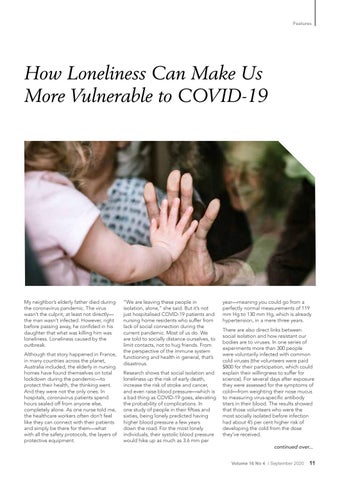Features
How Loneliness Can Make Us More Vulnerable to COVID-19
My neighbor’s elderly father died during the coronavirus pandemic. The virus wasn’t the culprit, at least not directly— the man wasn’t infected. However, right before passing away, he confided in his daughter that what was killing him was loneliness. Loneliness caused by the outbreak. Although that story happened in France, in many countries across the planet, Australia included, the elderly in nursing homes have found themselves on total lockdown during the pandemic—to protect their health, the thinking went. And they were not the only ones. In hospitals, coronavirus patients spend hours sealed off from anyone else, completely alone. As one nurse told me, the healthcare workers often don’t feel like they can connect with their patients and simply be there for them—what with all the safety protocols, the layers of protective equipment.
“We are leaving these people in isolation, alone,” she said. But it’s not just hospitalised COVID-19 patients and nursing home residents who suffer from lack of social connection during the current pandemic. Most of us do. We are told to socially distance ourselves, to limit contacts, not to hug friends. From the perspective of the immune system functioning and health in general, that’s disastrous. Research shows that social isolation and loneliness up the risk of early death, increase the risk of stroke and cancer, and even raise blood pressure—which is a bad thing as COVID-19 goes, elevating the probability of complications. In one study of people in their fifties and sixties, being lonely predicted having higher blood pressure a few years down the road. For the most lonely individuals, their systolic blood pressure would hike up as much as 3.6 mm per
year—meaning you could go from a perfectly normal measurements of 119 mm Hg to 130 mm Hg, which is already hypertension, in a mere three years. There are also direct links between social isolation and how resistant our bodies are to viruses. In one series of experiments more than 300 people were voluntarily infected with common cold viruses (the volunteers were paid $800 for their participation, which could explain their willingness to suffer for science). For several days after exposure they were assessed for the symptoms of cold—from weighting their nose mucus to measuring virus-specific antibody titers in their blood. The results showed that those volunteers who were the most socially isolated before infection had about 45 per cent higher risk of developing the cold from the dose they’ve received. continued over... Volume 16 No 4 I September 2020
11










